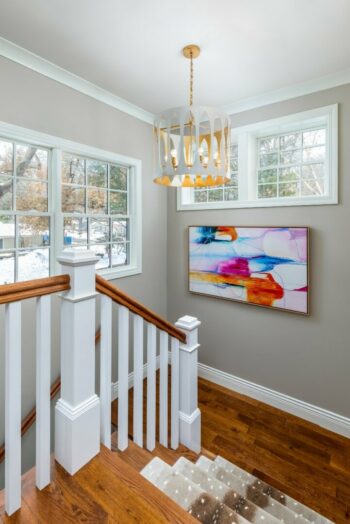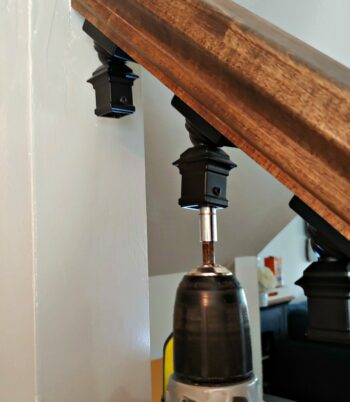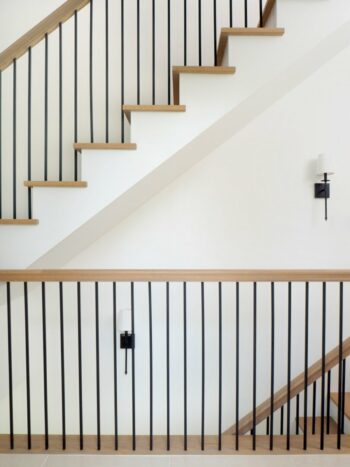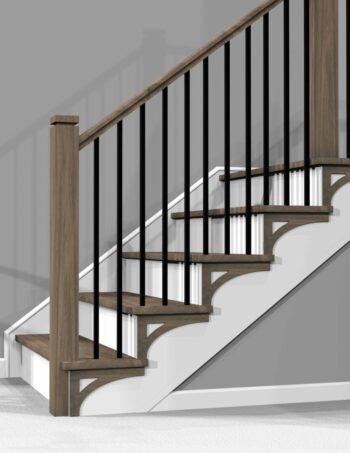
What to Know About Replacing a Stairway System
This blog was contributed by L.J. Smith.
Bowerston, OH – Replacing an interior stairway system is a big step for a homeowner. Literally. However, with the help of a building professional, the stunning transformation results make it worth the effort. To make the job easier, industry experts offer a variety of recommendations, from design style to technical details, to make an interior stairway replacement a focal point in the home.
Make a Big Impact
“A stairway renovation can be the show-stopping element that makes the biggest impact on your entryway,” says Tamara Day, host of HGTV’s Bargain Mansions television show. “Oftentimes stairways are overlooked, which is a mistake.”
Day suggests that the stairway presents an opportunity to be both bold and dramatic with your personal style. “I like to consider the spindles (or balusters) as the repetitive element that adds drama,” says Day. “If your house is traditional, try going a bit modern with the spindles to layer the style. If there’s lots of woodwork in the entry, add in a painted handrail for contrast. If you have tile flooring, go for a wooden railing and spindles to warm up the space. Overall though, make sure you fall in love with the details … they truly make the design!”
Martin Crandell, owner of Martin Stairways in Calif., agrees with many of the points made by Day. “People need to consider the flooring in the area around the stairs,” says Crandell, who installs more than 100 stair systems each year. “Most of the time there’s wood flooring, and the idea is to have your stairway either match or really contrast the wood species.”
Crandall points out that homeowners should understand the difference between stair wood and flooring wood. “Stair wood is painted or stained after it’s installed,” says Crandell. “Flooring wood comes pre-stained. Stair wood gets its coating on location once the project is complete.”
Tips to Add Style
Before Tom Kraeutler started hosting The Money Pit home improvement radio show and podcast, he spent a number of years building stairs and installing railings in homes across the nation.
“For many builders, railings are seen simply as a code requirement, and not as a design element or opportunity,” says Kraeutler. “That’s a mistake. Many stock houses have just one or two railing designs – either wood ‘colonial’ style or prefabricated metal railings. These both can look cheap and kind of cheesy.”
“The good news is that homeowners can get a new look for their stairway system in a matter of hours. By switching out old-styled wood balusters to newer iron balusters you get a new look to your stairway quickly. This creates a totally improved ‘first impression’ for people entering the home.”
Swapping Out for Iron Balusters
 The IronPro system from L.J. Smith Stair Systems keeps the structural aspect of the stairway, but allows homeowners to add in iron balusters. The IronPro level kit includes both a pivoting top piece and a stationary bottom piece.
The IronPro system from L.J. Smith Stair Systems keeps the structural aspect of the stairway, but allows homeowners to add in iron balusters. The IronPro level kit includes both a pivoting top piece and a stationary bottom piece.
After removing the existing wood baluster, the pivoting fasteners of the IronPro are attached to the handrail. Then the new iron baluster is measured and cut. The iron baluster is then inserted into the pivot fastener and swung into a vertical position. The assembly is aligned and screwed into place to secure the baluster. It’s that easy.
Two different IronPro kits are available from L.J. Smith, both featuring products in Satin Black and Low Sheen Black. For an open tread stairway, the IronPro Level Kit includes a ball adaptor, round and rectangular sockets, a base collar, a threaded disk and centering plugs. For a kneewall stairway, the IronPro Kneewall Kit includes a ball adaptor, threaded ball adaptor, round and rectangular sockets and centering plugs.
One IronPro kit is needed for each baluster replacement in a stairway system. L.J. Smith offers 35 different ½” solid and hollow iron baluster styles as replacement options when using the IronPro kit.
Sweet Spot: Risers, Treads and Brackets
 Before jumping ahead and starting a stairway replacement project, it’s important to understand the components of a staircase. Stringers are the sloped boards that support the weight of where a person stands on the stairs. Treads are the tops of every step. And finally, risers are installed under the lip of each tread, hiding the stringers and closing the space between treads.
Before jumping ahead and starting a stairway replacement project, it’s important to understand the components of a staircase. Stringers are the sloped boards that support the weight of where a person stands on the stairs. Treads are the tops of every step. And finally, risers are installed under the lip of each tread, hiding the stringers and closing the space between treads.
Checking on local building codes should be the first step before starting a stair replacement project. There may be newer codes homeowners need to adhere to that were not in place when an older stairway was installed. If replacing the entire stairway, this can mean a significant change in the design or measurements involving risers and treads.
After gathering code information, builder Tim Carter recommends trying to get the “sweet spot” for positioning risers and treads.
“A 7.5-inch riser, coupled with 10-inch treads is ideal for a stairway,” says Carter, founder of AsktheBuilder.com. “You’ll discover stairs built with this combination are the most comfortable set of steps you’ve ever gone up or down!”
 Carter, who has installed L.J. Smith stair systems in his own home, suggests that homeowners consider unique elements to make their stairway system truly original. The stair company offers Reversible Stair Risers featuring a shiplap design on one side and a beaded planking design on the other, making it easy for building industry professionals to create an entirely new look for a stair system.
Carter, who has installed L.J. Smith stair systems in his own home, suggests that homeowners consider unique elements to make their stairway system truly original. The stair company offers Reversible Stair Risers featuring a shiplap design on one side and a beaded planking design on the other, making it easy for building industry professionals to create an entirely new look for a stair system.
Made of Primed Poplar, the Reversible Stair Risers are mitered to the stringer and come in various lengths. Installed during the construction of a new stairway, the risers can be painted an accent or complementary color.
L.J. Smith also offers a variety of Decorative Stair Brackets as a way for contractors and builders to add a ‘wow factor’ to a stairway. Designed for installation below stair tread returns or on stair risers, the on-trend stair brackets come in two unique designs – a sleek, straight Mission-style Craftsman bracket or a softly-curved Modern shape. Each wooden bracket comes in left- and right-hand configurations. Available in Red Oak for staining and Birch for painting, the decorative brackets can be installed by professionals in a variety of ways on a stairway.
About L.J. Smith
L.J. Smith, a Novo Building Products Company, offers a wide variety of products including wooden and ornamental iron balusters, metal panels, stainless steel cable and tube infills, metal panels, newel posts, hand rails and accessories. All products are defined by their unique designs, uncompromised durability and good looks. For more information, visit http://www.ljsmith.com.